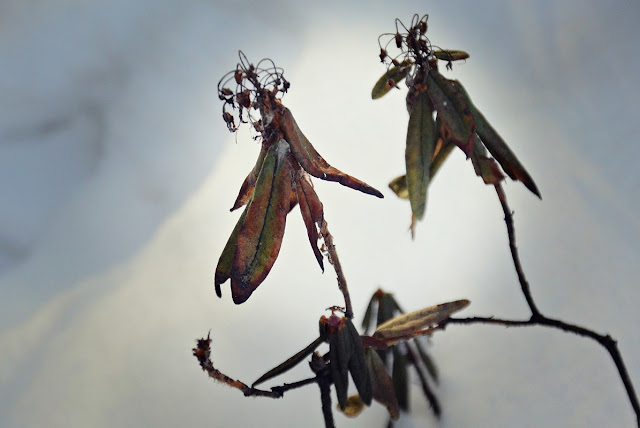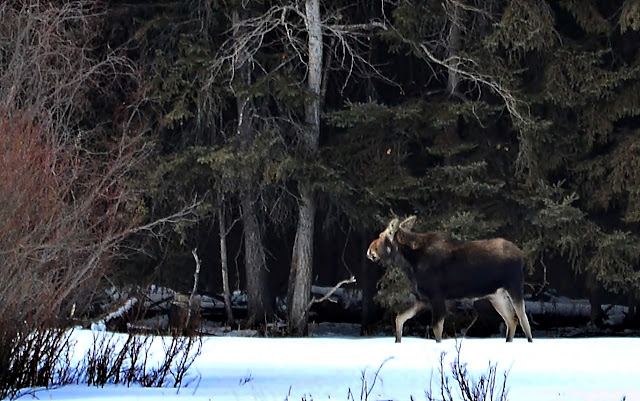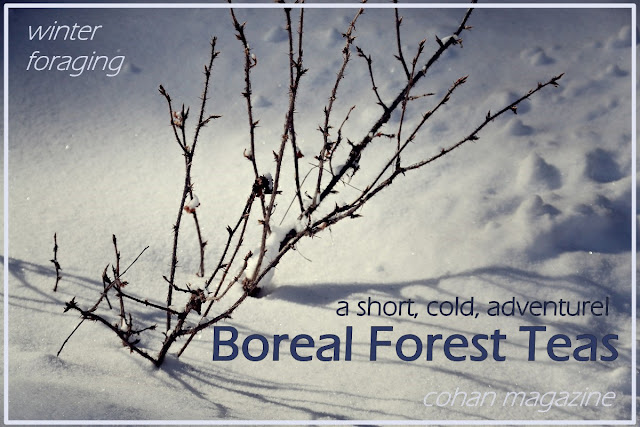I like coffee, simple fact. But I also like other kinds of hot beverages, such as herbal 'teas' (the words used: tea, tisane, herbs, infusion, decoction are a subject to themselves, but not for now), both to keep my coffee consumption moderate, and because I think there are potential health benefits from simple preparations made from various plant bits (leaves, stems, roots, fruits). I'm not talking herbal medicine, though that can be closely related, but just pleasing drinks which might have vitamins, minerals, phytonutrients, just a support to general wellness. Think: foods, herbs, spices that are good for you. But as a hot drink.
To that end, I've bought a range of prepared tisanes/ herbal teas over the years, and made my own with spices and a few wild and garden herbs. I haven't done enough preparation, though, from leaves, fruits etc to have a stocked tea cupboard for the winter, so I decided to look into things I could forage right now in the middle of winter. Okay, so it is March first, and should be pre-spring, but we've been cold pretty much since the beginning of February, and a few more days to go till we get a sustained (but still below average) warm-up, so believe me, it felt like the middle of winter out there, below -20C when I was out, and heading well below -30C overnight.
So, winter teas at the edge of the Boreal Forest. Well, it turns out some of our most common species can be used (most have food uses as well, subject for another day)-- Spruce (as well as other conifers, with some exceptions, so please research your local species before jumping in), Birch and Tamarack. The preparation is similar for all-- collect small branch tips (with needles of course, for the spruce, the others will be bare in winter); aim for the young, lively looking twigs, flavour should be better than older, drier parts. you can chop or crush the twigs/needles to release more flavour, or leave them whole, pour boiling water over, and let steep for a while-- I'd cover and aim for at least 10 minutes, but experiment (some may need longer, hotter preparation if you want stronger tastes, but you should read up on the pros and cons). Then strain out the material and enjoy-- add a dash of honey or maple syrup if you like.
I intend to experiment with bits of spices or herbs added as well, but since I'm new to this, I'll try each one by itself to get a sense of the flavours, and how much material is needed. Most of these can also be boiled for stronger flavour-- that feels to me more like you'd be heading in a medicine direction, so if you are going that way, do some more reading on the subject.
Foraging was interesting on a cold wintry day-- these species are all available either in the yard, or nearby on the acreage or farm just beyond, so not hard to access, but the cold and snow from a few inches to just below the knee played a role in my choices of where and how far to go on a lazy afternoon! I would not choose trees near the road, by choice (if you must, look for branches on the far side of the tree, away from dust and pollution, and wash extra carefully.
In the case of White Spruce / Picea glauca I also decided to go for young trees, since the large ones here are squirrel habitat, and I wasn't interested in squirrel dirt tea! I chose young branch tips which I hoped would have the most zing. Someday I will try (much less common here) Black Spruce / Picea mariana to see if it is any different tasting!
 |
| Picea glauca / White Spruce / foraging young tips for tea |
Since I was in the right spot, I thought I'd collect a few leaves of Labrador Tea / Rhododendron (Ledum) groenlandicum. This grows at the back of the acreage, but there are not huge numbers of plants, and they do not grow fast, so I've never wanted to harvest leaves to try. I finally decided that taking a few leaves would not hurt the plants, and frankly, though the plants are more or less evergreen, these freeze-dried mid-winter leaves above the snowpack are not likely to do much next season anyway. I just took two little clusters. While this is a traditional herb with long history of use, there is some concern about toxicity-- there are a couple of components which can be medicinal, narcotic. We know that medicines should not be used in excessive doses, and the same applies to medicinal plants. Of the three ex-Ledum species, groenlandicum has the lowest levels of the toxins, but there is variation by growing site.
 |
| Labrador Tea / Rhododendron groenlandicum / Ledum groenlandicum/ Hudson's Bay Tea |
 |
| Tamarack / Larix Laricina, Winter Forest Tea Foraging |
Paper Birch / Betula aff B. papyrifera (we have a couple of species of birch which may intergrade, giving us some variable trees, but these are more or less Paper Birch). Another key northern species with many uses from food to clothing to shelter. The small twigs are said to give a nice infusion. I'm wondering if they will be even nicer in spring when the sweet sap ( can be used to make syrup) is flowing? I'll need to try that.. My biggest challenge on this one was finding tip twigs that I could reach-- the moose had eaten all the lower tender bits, and moose are tall! As with the Tamarack, I had to reach up full extension, grab a branch and pull it down to reach the end twigs. On a happy note, what I thought were last year's remaining seed clusters on higher branches were actually new catkins beginning-- so this Birch at least thinks we have spring coming some day!
 |
| Paper Birch / Betula aff B. papyrifera, moose pruned branches |
 |
| Paper Birch / Betula aff B. papyrifera, winter catkins |
My last stop was for Willow /Salix - a well known medicinal, but I wanted it not to take internally, but rather tomake willow water, used to help plant cuttings root. (I need to do more research on that topic-- for the moment I just dropped the willow cuttings into a cup of water with some other cuttings!). This (several species here) is one of the favourite foods of the moose, and willows on the farm are heavily pruned on all branch tips, until/unless they manage to get some taller stems out of reach of the browsers. For this use, I didn't care whether I got tender branch tips, nor did I care about moose spit-- if I were making a tea/medicine for me, I'd have hunted some taller willows to try to get the spit-free upper branches!
 |
| Willow / Salix, moose pruned |
 |
| Alces alces / Moose, West Central Alberta |
 |
| Alces alces / Moose, West Central Alberta |

Comments
Post a Comment